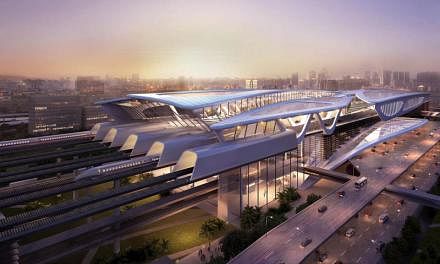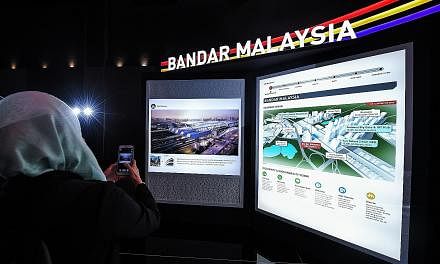Singapore and Malaysia signed a Memorandum of Understanding on Tuesday (July 19) that paves the way for more detailed planning and eventual construction of the long-awaited High Speed Rail connecting the two countries.
The rail link between Singapore and Kuala Lumpur is targeted to be up and running by around 2026, cutting the travelling time between both cities to 90 minutes.
The two terminal stations will be at Jurong East in Singapore and Bandar Malaysia in KL. The High Speed Rail line will pass through another six intermediate stations in Malaysia that will be connected by a domestic service. These stations are Iskandar Puteri, Batu Pahat, Muar, Ayer Keroh, Seremban and Putrajaya.
Here is a look at successful high speed rail systems in other parts of the world.
This article was first published on April 20, 2014 and updated on July 19, 2016.
South Korea
The launch of the high-speed rail (HSR) in South Korea in 2004 has improved accessibility and halved inter-city commuting time.
The Korea Train eXpress, or KTX, which runs at 300kmh and takes just 52 minutes to go from Seoul to Daejeon. The longest journey on the KTX from Seoul to the south-eastern port city of Busan - 325km away and on the main Gyeongbu Line - takes just 21/2 hours, compared with over four hours using regular trains
About 150,000 people use the KTX every day, double the 71,000 figure when it started operating.
Official data shows that 39.2 per cent of commuters travel to visit friends or relatives, 29.3 per cent for work or business trips, and 20.4 per cent for sightseeing.
Japan
The world's first high-speed rail line, Japan's Shinkansen (new trunk link) rail network was opened in 1964.
Beginning with 515.4km of rail in 1964, the network has since expanded to cover almost 2,700km of lines, linking most major cities on Japan's main islands of Honshu and Kyushu.
Currently, the Shinkansen's maximum operating speed is 320kmh, but test runs have reached upwards of 443kmh on the conventional rail line and up to 581kmh - a world record - on the maglev trainsets.
One of the world's busiest high-speed rail lines, the Shinkansen boasted the highest annual passenger ridership until 2011, when China's high-speed rail network surpassed it at 370 million passengers a year.
China
China currently boasts the world's longest high-speed rail network, with 9,356km of tracks including the world's longest line, the Beijing-Guangzhou line, which is 2,298km.
The China Railway Corporation, which owns most of the network's high-speed rail lines, is also rapidly expanding the rail network, with 18,000km of track expected to be completed by end-2015.
However, the 2011 arrest of then-Railway Minister Liu Zhijun for corruption delayed expansion efforts, with authorities concerned that safety may have been compromised on some of the construction.
The fastest train service in China is the Shanghai Maglev Train, which can reach speeds of up to 431kmh. However, the average operational speed is 245.5kmh, due to the limited length of the Maglev track.
Germany
Germany's InterCityExpress (ICE) first began service in 1991, and connects not just major cities like Hamburg and Berlin, but also other countries like Switzerland and the Netherlands.
In 2000, third-generation ICE trains were introduced, which have a service speed of 330kmh.
Germany also operates the Transrapid maglev train system, which can reach speeds up to 550kmh. China's Shanghai Maglev Train, which was built in collaboration with Siemens, uses Transrapid technology.
France
The French high speed train is also known as the TGV (Train à Grande Vitesse), and it refers to not only to the some 350 trainsets in service today, but also to the system which comprises train, track and signalling technologies that make high speeds of 300kmh possible.
The TGV was launched in the late 1960s and opened to the public in 1981 when the service from Paris to Lyon opened in 1981. The system now consists of three major trunk lines radiating out of Paris, the most recent one being the Nord-Europe line. Opened in 1993, it connects Paris to Lille, Belgium, the Netherlands, Germany and Britain through the Channel tunnel. On Nov 28, 2003, TGV network carried its one billionth passenger.
Extensions are still being built, and the biggest of the three projects currently underway is the new line between Tours and Bordeaux halfway down the Atlantic coast.
Spain
Spain started high-speed rail system in 1992 with the opening of the Madrid-Sevilla (Seville) route.
Known as Alta Velocidad Española (AVE) and operated by Renfe Operadora, the Spanish national railway company, the service now runs the longest network in Europe and second in the world after China, with 3,100km of track and 1,800km under construction.
In December 2013, direct high-speed trains, travelling at speeds of up to 300kmh, began running between Spain and France, connecting the Spanish high-speed rail system with the rest of Europe.
There are more than 300 high-speed trains in service in Spain every day, serving about 100,000 passengers and around 80 Spanish cities and towns.













